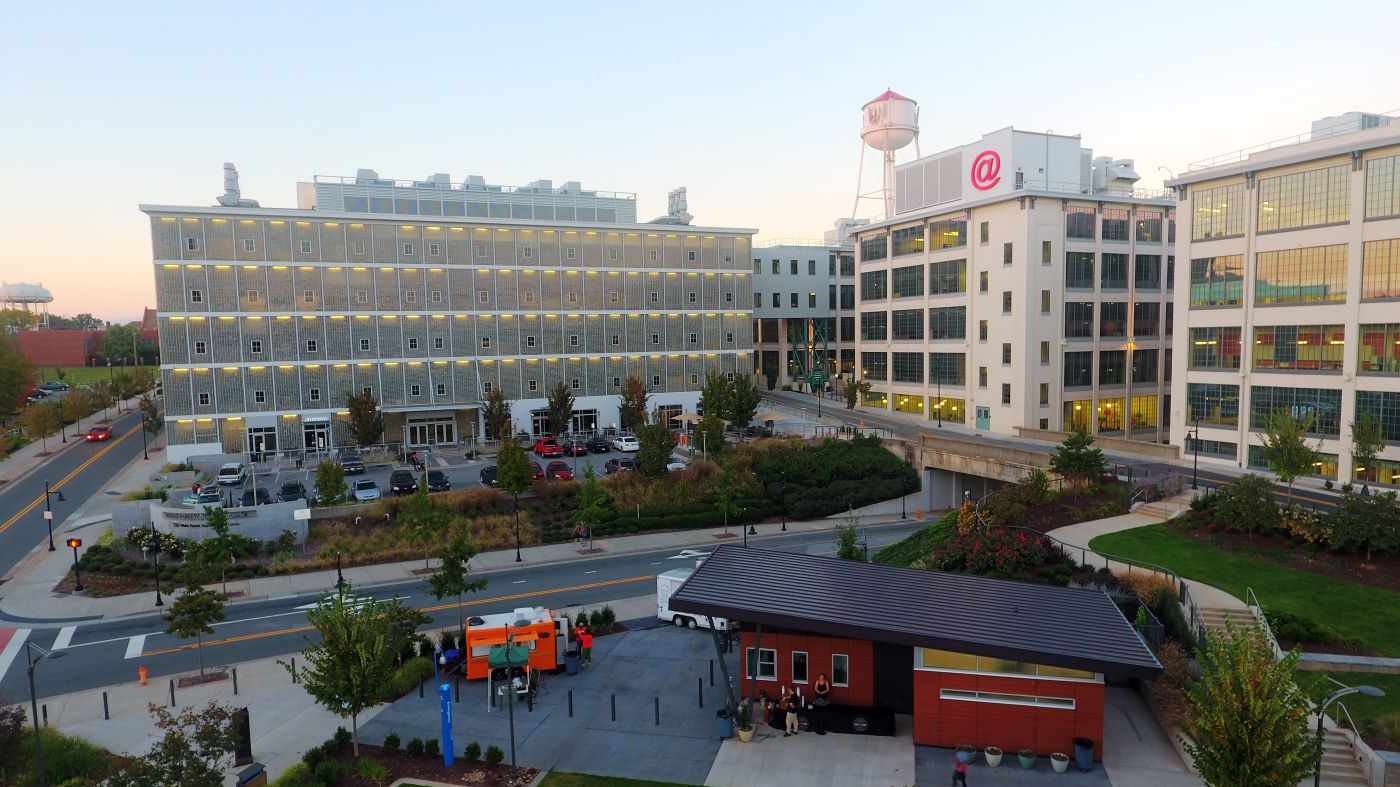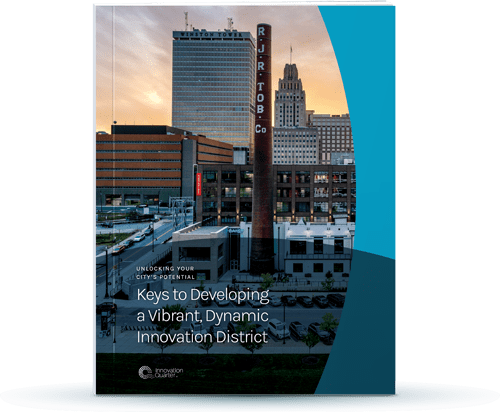
Innovation Districts Are Here to Stay
Innovation districts are transforming urban landscapes, creating communities, and shaping the future.

Bold, forward-thinking ideas are emerging across the country, many focusing on creating a more equitable and inclusive future. From healthtech solutions to community transformation initiatives, strategic collaboration between entities from like and disparate industries leads us to a future far greater than any organization could accomplish alone—and that’s where innovation districts come in.
Building an innovation district takes a village. But with the right strategies and partnerships, it can manifest a vibrant community. From driving economic growth to fostering inclusive collaboration, there are some key tactics you don’t want to overlook, including:
- Best practices to building innovation districts and ecosystems
- Ways to weave equity into your city’s identity through diversity and inclusion strategies
- How to facilitate and leverage partnerships that can shape your city’s innovation landscape
What Is an Innovation District?
Visit almost any thriving metropolitan area, and you’ll notice at least one thing they have in common—a section of the city that’s buzzing with activity. Here you’ll find professionals, students and families mingling amongst each other; buildings that house everything from start-ups to minority-owned businesses to national corporations; and amenities like public art and green space. There’s no doubt that these few blocks are the heart of the city—an innovation district dedicated to community development and entrepreneurship.


An innovation district is a concentrated area of physical spaces that cluster entrepreneurs, medical institutions, start-ups and academia. The Brookings Institution credits density, proximity, accessibility and mixed-use spaces as what’s needed to create an environment ripe for collaborating, networking and living. These districts blend economic, physical and networking assets in a way that encourages connection. They are blurring lines that divide where we work, live and play, and are becoming crucial pieces of local and regional economic development strategies. They are typically:
Access Our Innovation District Playbook for More Insights and Expertise







Innovation District Best Practices: 3 Ps of a Successful Innovation District
Innovation districts are popping up across the world, dismantling the norms of the workaday world and breathing new life into under-performing spaces. However, many underestimate what goes into establishing one that can drive such transformative disruption. It isn’t just about reinventing shared physical spaces—it’s about creating intimate connections between people and companies. Intentional planning, placemaking and programming are our top three innovation district best practices.
1. Planning: Community Input is Integral to a Healthy Innovation District
Innovation districts cannot thrive on top-down strategies. They require a mission that is anchored in the community, engages a diverse range of people and provides opportunities for workers of all skill and education levels. This kind of equitable environment can only be achieved through listening to the voices of the community and developing a strategy based on grassroots needs of (but not limited to) people of color, women and the LGBTQ+ community.


Planning is a critical phase—and innovation district best practice—when partners are assessed and goals are identified, but it’s also an important starting point in developing a strong relationship with the community. Many districts emerge from or near underserved and low-income neighborhoods and have the potential to be a catalyst for change within those areas. Engaging the community not only increases chances of buy-in and support, but it also provides stakeholders with a perspective that’s crucial to development. Community members can best articulate what issues plague the area and the resources that would be most meaningful to the population.
2. Placemaking: Creating an Emotional Connection Between Physical Spaces and the Community
Placemaking is both a philosophy and a process: It stems from a vision to create spaces that contribute to people’s health, happiness and well-being and manifests itself as re-imagined everyday spaces, like parks, downtowns, streets and public plazas.
Innovation districts blur the lines between public and private, living and working and academic and corporate spaces. The fluidity of space nurtures a convivial spirit that permeates throughout the community and becomes part of its identity. Placemaking is one of the innovation district best practices that has the power to affect quality-of-life measures, including:
- Sociability: volunteerism, evening use and strength of social networks
- Accessibility: transit usage and walkability
- Usability: local business ownership, property values and rent levels
- Livability: crime statistics and sanitation ratings
3. Programming: Activating Spaces within an Innovation District
Programming is a fundamental aspect of placemaking and is vital to the success of an innovation district. Simply creating the space and making it accessible is not enough of a reason for people to come. Programming encourages participation from people of all ages, abilities and socioeconomic backgrounds while also serving as a community resource.
Facilitating social connections through programming—activities that teach skills, strengthen connections and build networks—is the most effective pathway to building a healthy innovation district. Inclusive and authentic programming will become the lifeblood any innovation district, encouraging bonds that are vital to innovation and social justice.





Access Our Innovation District Playbook for More Insights and Expertise
How Leading Innovation Districts Realize Diversity and Inclusion
Not unlike the innovation process, collaboration and diversity play a role in advancing inclusion. However, realizing a genuine sense of inclusion also requires intention. Leading innovation districts are built on strategies where inclusion is woven into all aspects of its development—and it shows. These areas become vibrant, dynamic ecosystems where inclusion and diversity become part of their identities and create opportunities equitably throughout the community.
The Global Institute of Innovation Districts has gathered insights from over 100 districts and found that three strategies are common among the most successful innovation districts:


Leverage assets—economic, physical and social—to build an innovation ecosystem.


Provide deliberate and sophisticated support of placemaking, entrepreneurial endeavors and cross-industry collaboration.


Implement inclusion and social innovation strategies that address longstanding and complex inequality challenges.
The research highlights how innovation districts bring cross-sector collaboration and innovation critical to local economic development and growth, especially for the underserved communities upon which they are often built. To quell the consequences of (and not contribute to) the disparities across racial, social and economic divides, it’s proven that innovation district strategies must be intentional and emphasize inclusion.
We’re innovating faster than ever before.



Today’s innovation environment requires a community-minded, inclusive approach—and that’s where innovation districts are rewriting the script of collaboration.
These high-demand areas embrace density and proximity: They are unique communities that are intentionally designed to encourage organic, intellectual collisions and jump-start inclusive economic growth. With the right mix of strategies, partners, and amenities, innovation districts become safe, desirable spaces that are the hearts of their cities.
Developing an innovation district is an intentional, inclusive, and ongoing process that brings life to a city while transforming underserved communities.
Our guide offers insight into how you could be shaping your city’s innovative landscape and unlocking its true potential.